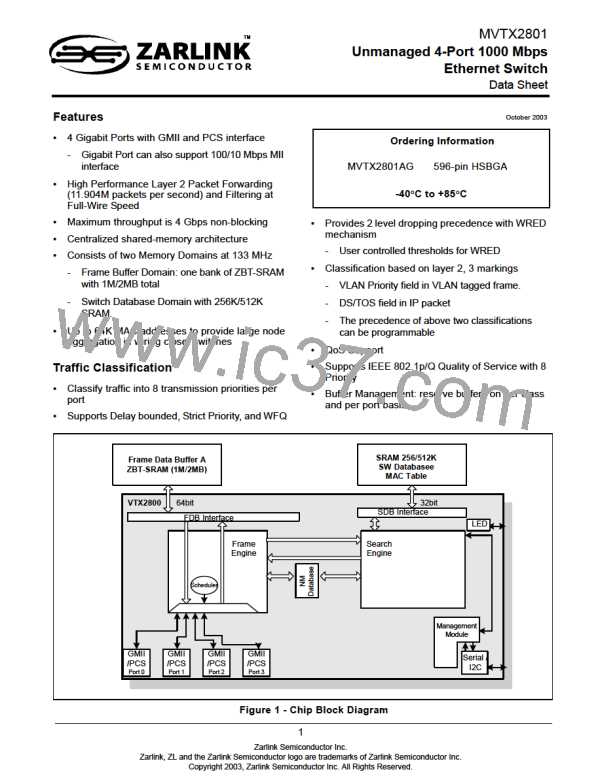MVTX2801
Data Sheet
Example
Assured
Low Drop Subclass
(If class is oversubscribed,
these packets are the
last to be dropped.)
High Drop Subclass
(If class is oversubscribed,
these packets are the
first to be dropped.)
Class
Bandwidth
(user defined)
Highest transmission
priorities, P7
300 Mbps
200 Mbps
125 Mbps
250 Mbps
80 Mbps
45 Mbps
Sample application:
control information
Latency < 200 µs
Highest transmission
priorities, P6
Sample applications:
phone calls;
Sample application:
training video;
Latency < 200 µs
circuit emulation
other multimedia
Middle transmission
priorities, P5
Sample application:
interactive activities
Sample application:
non-critical interactive activities
Latency < 400 µs
Middle transmission
priorities, P4
Sample application:
web business
Latency < 800 µs
Low transmission
priorities, P3
Sample application:
file backups
Latency < 1600 µs
Low transmission
priorities, P2
Sample application:
email
Sample application:
web research
Latency < 3200 µs
Best effort, P1-P0
TOTAL
-
Sample application: casual web browsing
1 Gbps
Table 1 - Two-dimensional World Traffic
It is possible that a class of traffic may attempt to monopolize system resources by sending data at a rate in excess
of the contractually assured bandwidth for that class. A well-behaved class offers traffic at a rate no greater than the
agreed-upon rate. By contrast, a misbehaving class offers traffic that exceeds the agreed-upon rate. A misbehaving
class is formed from an aggregation of misbehaving microflows. To achieve high link utilization, a misbehaving class
is allowed to use any idle bandwidth. However, the quality of service (QoS) received by well-behaved classes must
never suffer.
As Table 1 illustrates, each traffic class may have its own distinct properties and applications. As shown, classes
may receive bandwidth assurances or latency bounds. In the example, P7, the highest transmission class, requires
that all frames be transmitted within 0.2 ms, and receives 30% of the 1 Gbps of bandwidth at that port.
Best-effort (P1-P0) traffic forms a lower tier of service that only receives bandwidth when none of the other classes
have any traffic to offer.
In addition, each transmission class has two subclasses, high-drop and low-drop. Well-behaved users should not
lose packets. But poorly behaved users, users who send data at too high a rate, will encounter frame loss, and the
first to be discarded will be high-drop. Of course, if this is insufficient to resolve the congestion, eventually some
low-drop frames are dropped as well.
Table 1 shows that different types of applications may be placed in different boxes in the traffic table. For example,
web search may fit into the category of high-loss, high-latency-tolerant traffic, whereas VoIP fits into the category of
low-loss, low-latency traffic.
18
Zarlink Semiconductor Inc.

 ZARLINK [ ZARLINK SEMICONDUCTOR INC ]
ZARLINK [ ZARLINK SEMICONDUCTOR INC ]